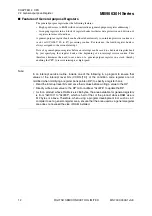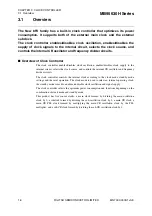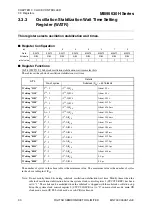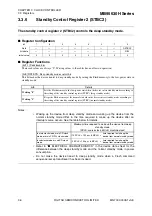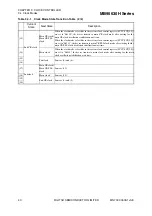
MB95630H Series
MN702-00009-1v0-E
FUJITSU SEMICONDUCTOR LIMITED
25
CHAPTER 3 CLOCK CONTROLLER
3.2 Oscillation Stabilization Wait Time
■
PLL Clock Oscillation Stabilization Wait Time
As with the oscillation stabilization wait time of the oscillator, when a request for state
transition from PLL oscillation stopped state to oscillation start is generated due to an interrupt
in stop mode or a change of clock mode by software, the clock controller first waits for the
main CR clock oscillation stabilization wait time to elapse, and then automatically waits for the
PLL clock oscillation stabilization wait time to elapse.
Table 3.2-2 shows the PLL oscillation stabilization wait time.
*: F
MCRPLL
= 16 MHz
■
CR Clock Oscillation Stabilization Wait Time
As with the oscillation stabilization wait time of the oscillator, when a state transition request
making CR oscillation start from the CR oscillation stop state is generated due to a change of
clock mode caused by an interrupt in standby mode or by the software operation, the clock
controller automatically waits for the CR oscillation stabilization wait time to elapse.
Table 3.2-3 shows the CR oscillation stabilization wait time.
*1: F
CRH
= 4 MHz
*2: F
CRL
= 150 kHz
■
Oscillation Stabilization Wait Time and Clock Mode/Standby Mode Transition
If state transition occurs, the clock controller automatically waits for the oscillation
stabilization wait time to elapse whenever necessary. Depending on the circumstances under
which state transition occurs, the clock controller does not wait for the oscillation stabilization
wait time to elapse even if state transition occurs.
For details on state transition, see "3.4 Clock Modes" and "3.5 Operations in Low Power
Consumption Mode (Standby Mode)".
Table 3.2-2
PLL Oscillation Stabilization Wait Time
PLL oscillation stabilization wait time
Main CR PLL clock
2
12
/F
MCRPLL
*
Table 3.2-3
CR Oscillation Stabilization Wait Time
CR oscillation stabilization wait time
Main CR clock
2
10
/F
CRH
*1
Sub-CR clock
2
5
/F
CRL
*2


